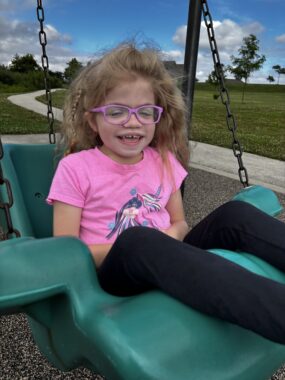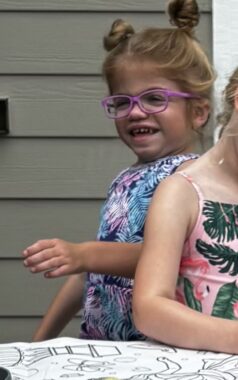How my daughter with Sanfilippo handles birthday parties
At celebrations of aging, the difference is clear with my special needs child
Written by |

My 5-year-old daughter, Liv, has Sanfilippo syndrome, a form of childhood Alzheimer’s. In her current phase of the disease, she’s hyper, impulsive, and has no sense of danger. Cognitively, she’s akin to a 1 year old. That makes play dates and birthday parties a large challenge.

Liv enjoys her time swinging. (Courtesy of Erin Stoop)
I’m extremely grateful for any invite that’s sent Liv’s way. If we’re free and the function is appropriate for her, I’ll always try to help her attend.
But I need to put my comparison eyes away when we arrive. When I see girls acting age-appropriate for 5, I can’t let my mind slip into “That’s what Liv should be doing” or “Liv is so far behind them.” That’s not good for me or Liv.
Right now at these types of gatherings, Liv cannot sit still. She’ll pace back and forth between rooms. She may find a toy or two that she’ll fixate on, but she won’t interact much with the other kids. She won’t give hugs, she cannot talk, she won’t sing “Happy Birthday,” and she won’t sit still for a photo. My mind wonders, “Why are we even here?”
Then I see her smile. She loves watching these kids from a distance. When she giggles, I can see her big grin through her pacifier.
Observing the benefits
I see other girls attempting to interact with her. I can tell they know she’s special, and they’re making an effort. That’s incredibly sweet. I don’t remember going out of my way as a kid to befriend a classmate with special needs, so when I see children including Liv or interacting with her, I have so much respect for them and their family.

Liv enjoys a recent birthday party. (Courtesy of Erin Stoop)
Not only does Liv need those type of interactions with other kids, it’s important for those neurotypical kids to interact with her, to be exposed to special needs or kids with disabilities. Kids are curious, and I don’t mind explaining a little bit more about why Liv is behaving differently than everyone else.
I don’t get to sit down much at these get-togethers, as I’m a “helicopter mom” right behind Liv’s every move. She needs help with stairs. If it’s an outdoor event, she’ll run into a neighbor’s yard or into the street. If it’s indoors, she’ll grab a glass picture frame on the wall and drop it, or she’ll grab the kitchen knife the mom is using to cut the cake. I joke that she’s a magnet for trouble. And she can get into trouble, quickly.
We’re at the point where parents may no longer be attending these birthday parties, but I’ll never be able to drop Liv off at one, as others do. She needs to be watched by someone who knows her well, constantly.
I know that hiding Liv at home isn’t the answer, but these birthday parties are going to get harder. These girls will get older, and their differences will continue to be more obvious. I believe Liv’s brain damage will always keep her oblivious to these differences. I’m grateful for that now, but I won’t be. I fear the day when I hear a child bully Liv, or ask that Liv no longer come because it makes them uncomfortable.
We have some friends with neurotypical kids, and they’ll always be there for us, I have no doubt. I’m so grateful for their friendships. I’ll need to guard my heart and ensure that every event we attend is not only safe for Liv, but also in the best interest of everyone.
Note: Sanfilippo News is strictly a news and information website about the syndrome. It does not provide medical advice, diagnosis, or treatment. This content is not intended to be a substitute for professional medical advice, diagnosis, or treatment. Always seek the advice of your physician or other qualified health provider with any questions you may have regarding a medical condition. Never disregard professional medical advice or delay in seeking it because of something you have read on this website. The opinions expressed in this column are not those of Sanfilippo News or its parent company, Bionews, and are intended to spark discussion about issues pertaining to Sanfilippo syndrome.



Leave a comment
Fill in the required fields to post. Your email address will not be published.